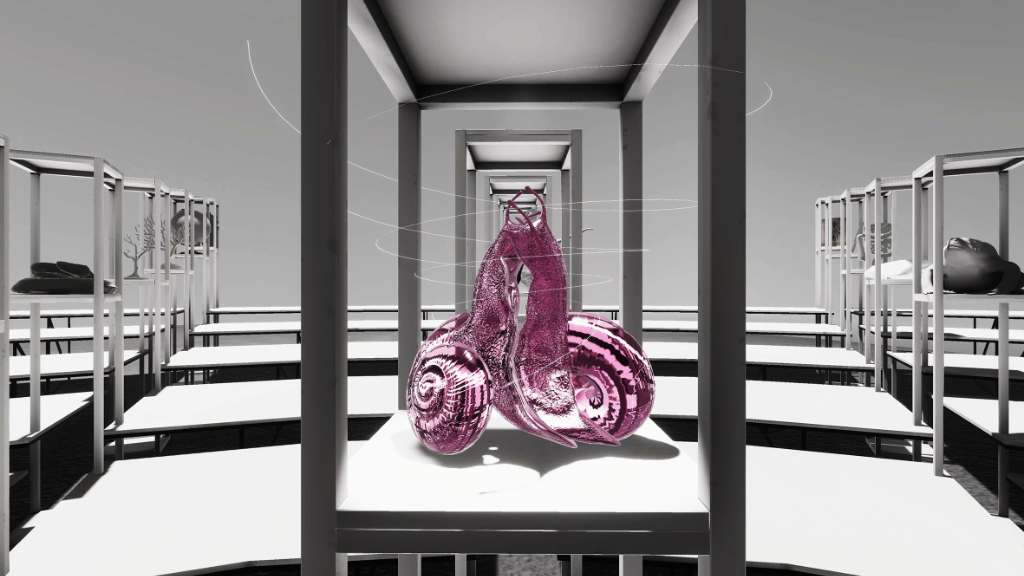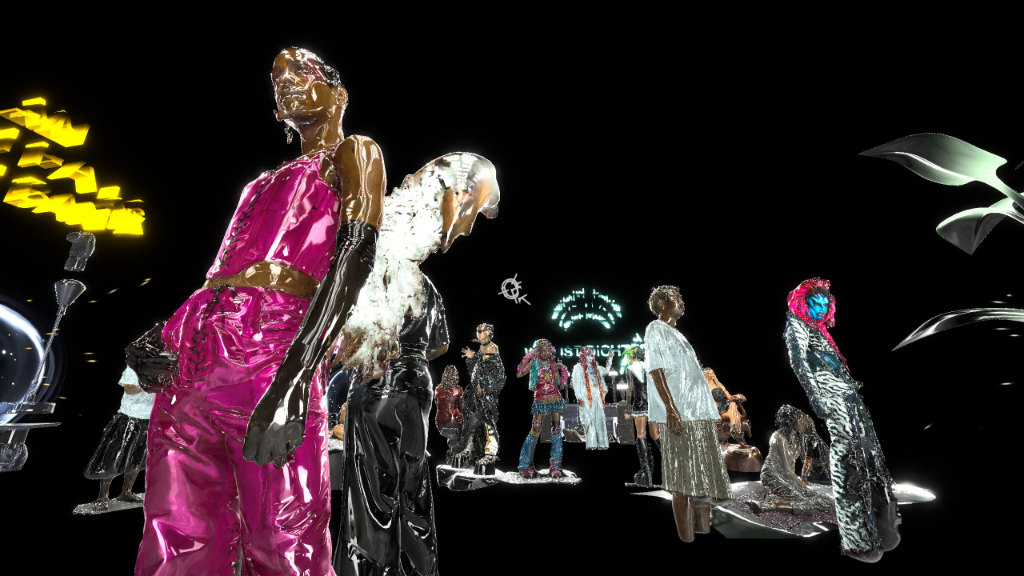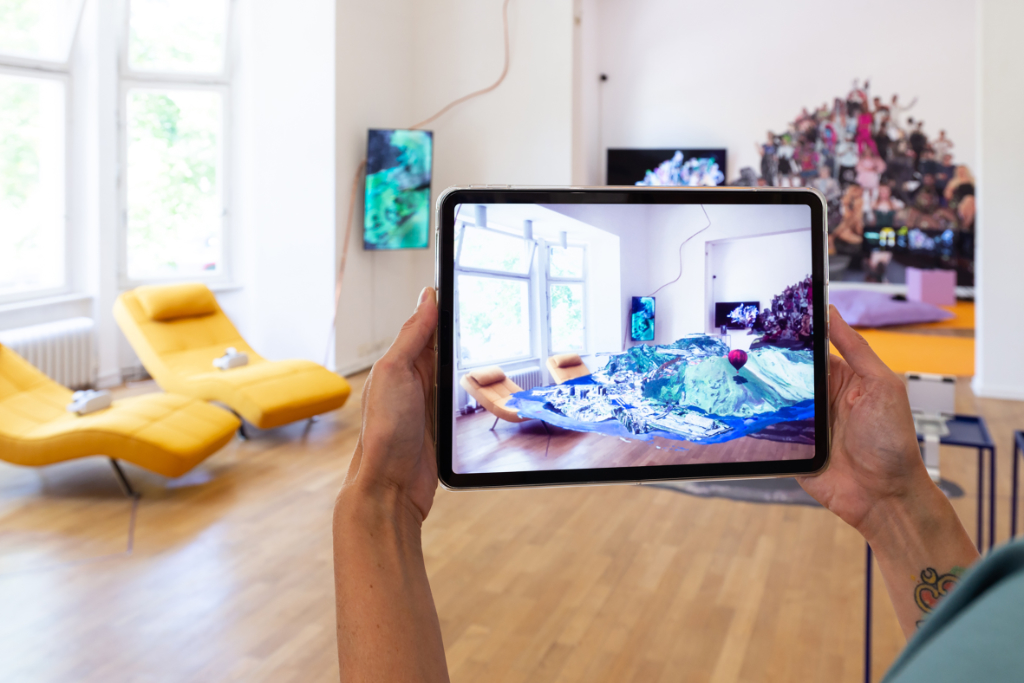Text by Juliette Wallace
![Mohsen Hazrati, Fãl Project [None-AI], 2023](https://clotmag.com/wp-content/uploads/2023/10/645a545efc64fe3a70ce9464_3.1-Mohsen-Hazrati-Fal-Projects-None-AI-2023-still-VR-KUNSTPREIS-2023-Cr.-Mohsen-Hazrati.jpg)
As technology continues to make its mark on the day to day, the art world is taking note. In a realm that creatively interprets the quotidian, the continued and rapid technological advances that are shaping all aspects of our lives are being scooped up, examined and represented by artists the world over. In their unique position as interpreters, communicators and catalysts for reality – imagined and actual – artists can approach the unknown with both vigilance and creative liberty, providing a universal entry into otherwise inaccessible truths. These ‘unkowns’, by virtue of both their unfamiliarity and their powerful nature, can be intimidating and are often represented in fear-driven imagined scenarios.
Robots taking over the world, AI becoming smarter than humans, a population of overweight loners stuck to VR headsets, conglomerates pushing moral boundaries beyond the point of return are just a few terrifying predictions portrayed over and over by a population full of dread. This reaction is understandable as there is much that we don’t know and thus fear about what may come to pass at the hands of the digital. But what if we used the power of positive thinking to re-imagine the re-imagined? What if instead of dystopias, we proposed utopias and gave the world something to believe in, to look forward to? This year’s VR ART PRIZE of the DKB in Cooperation with CAA Berlin has done just that in their current show, Unleashed Utopias: Artistic Speculations about Today and Tomorrow in the Metaverse.
As I enter the Haus am Lützowplatz in central Berlin, following an ascent up the somewhat treacherous metal staircase, I find myself confronted with a peculiar site. Throughout the five rooms of the beautifully laid-out and airy exhibition space are a scattering of people – standing and sitting – swinging their heads left and right, up and down, as they blindly reach out before them. They occupy seemingly designated spaces, delineated by silver circles, red egg-shaped chairs and bean bags, in and amongst the rest of the viewing public who are examining sculptures, photographs and screens peppered throughout the rooms.
As I step foot into the first space, the brightest and whitest, I get a closer look at one of these seemingly sightless individuals, groping the air and twisting their necks, and I realise that they are wearing a telling accessory: a VR headset. Within the reality of the Haus am Lützowplatz exists another reality, a virtual one, in which five artists have offered up their unique ideas of an alternative future where technology is a force for good, not evil.
Technology is often seen as dystopian in that it is new and, thus, threatening. We want to flip this view – Tina Sauerländer, Curator of Unleashed Utopias [1].
Now in its second year, the VR ART PRIZE has worked together with a panel of judges and curator, Tina Sauerländer, to display the works of a select group of artists in aid of dispelling the preconceptions of a gloomy techno-future in favour of propositions for something brighter. The five finalists, Marlene Bart, Anan Fries, Mohsen Hazrati, Rebecca Merlic and Lauren Moffatt, have each taken their own approach to representing what they see as an ideal way for humans and technology to co-exist, using VR technology to share this with the general public.
The organisers for the exhibition state: [t]he notion of a better world is closely tied to utopia as a theme. The term literally describes a wonderful place that does not exist. It means that the design for an ideal society is a criticism of the current situation [2]. This critical approach to our present is one that is both risky and necessary and it is to the organisers’ credit that they have brought it to our attention.


The DKB, a German bank that focuses on supporting social and sustainable issues, has set an example for money-making corporations worldwide by investing into what they see as an important field: the digital creative realm. Using their own funds, the DKB in collaboration with CAA Berlin has designed a prize which donates financial aid to a select group of artists, enabling them to carry out their expansive imagined worlds.
The DKB VR ART PRIZE – the first art prize for virtual reality in the field of visual arts in Germany – awards five working grants to visual artists who operate within the field of art and virtual reality. Each grant spans a period of four months, awarding 1,000 € per month to each selected artist. The culmination of the grant is a final exhibition, this year taking the shape of Unleashed Utopias. It is the reality of the complicated and intricate nature of technology that being an artist within the techno-art realm is often an expensive venture and thus the support of a well-stocked bank is, literally, priceless. And the investment seems to have paid off…
All five rooms of the Haus am Lützowplatz, as well as their exceptionally pretty outdoor garden area, are bustling with people who are highly engaged with their surroundings. The audience is largely a young one, ranging from around 20 to 30 years old, and their response to the art is tangible. The fact that the show, a rather heady combination of concepts and projections (literal and metaphorical), has been well-considered and beautifully curated means that the viewing public can effortlessly navigate their way around the building, stopping at TV screens, reading texts, popping on headphones and headsets and participating in the unique worlds that have been offered up to them by Bart, Fries, Hazrati and Moffatt.
It is credit to both the artists and Ms Sauerländer that the delineation between five simultaneous worlds is clear yet subtle, as is the combination of physical and virtual. This last element was important to the organisers who made a point in deferring from the exclusive realm of the purely digital by opting for real-life objects in each room. Historically, digital art has always been seen as different from other art and has been set apart from it. We want to change this [3].
Each of the spaces has their own specific aesthetic and colour scheme, lending itself to the themes of the works within. In the first room, Marlene Bart has worked with digitised natural history artefacts, bringing them to life in virtual worlds and producing a new perspective of our concept of nature. She has achieved this through making 3D scans of artefacts from Berlin’s Natural History Museum collection, reworking them so that particular details were changed or duplicated.
She then sent these “new animals” off to 3D printers and to the famous glass-blowing island of Murano, near Venice, Italy, where they were made physical. They are displayed in the exhibition on glassless shelves, a re-interpretation of the Wunderkammer human-centric, colonial practice of conquering and collecting. By removing the glass and creating a random hierarchy where height does not correlate to size or importance, Bart has turned this practice on its head.
The idea is to reconsider the Anthropocene, offering in its place a new perspective where non-human animals are just as important as us. VR glasses come into this through allowing us to really see from the perspective of the animals. The world that has been created is one made through artistic speculations and it is, to Bart, a possible utopia.
Room two is also a white space but it is scattered with a collection of objects and videos that are displayed in the air, on the ground, and across corners on paper, paint, stickers, copper poles, screens and, of course, VR headsets. This is the work of Australian artist, Lauren Moffatt, who has used her art to look at the interior human, gathering data via artificial intelligence and combining it with painting to create a multilayered, intimate landscape.
The interplay between the physical and the digital is perhaps best represented in this room where the artist has, through her own practice, gone back and forth between the two, first collecting hand-written stories from a selected nine human subjects, then using AI to interpret them, then painting them, then returning to the digital to process what emerged and, finally, using VR to create a whole 3D landscape of the inner workings of her interviewees.
The effect is fabulous and intimate and feels like something very special. The Island is divided into nine areas, each with their own unique landscape and it feels truly exceptional having access to such a personal part of a stranger’s insides. The utopia idea in this is to use data-gathering for good rather than cynical purposes, regaining control of our digital identity by creating alternative, non-commercial algorithms that create beauty and intrigue rather than generate funds for the 1 per cent.
![Anan Fries [Posthuman Wombs], 2023](https://clotmag.com/wp-content/uploads/2023/10/645a5331c6a1b9f358c4c4ec_1.1-Anan-Fries-Posthuman-Wombs-2023-still-VR-KUNSTPREIS-2023-Cr.-Anan-Fries-2.jpg)

In the third room, the idea of an inner landscape is revisited by the artist, Rebecca Merlic, who uses video game tactics to celebrate the liberation of binary identities, physical transformation, and the diversity of human individuality. The walls are covered in human-scale stickers of 3D prints in which selected queer individuals are shown as their “characters”. The main attraction is the Xbox sitting in the centre of the space, surrounded by bean bags (allowing for a truly humiliating experience for anyone over the age of thirty).
The game is one created by Merlic herself, portraying her collected subjects as static video game characters for the player to get to know through their uniquely curated digital worlds. The thought behind the work is to give power to the marginalised and bring them to the public through their own choices rather than in headlines or through social media.
Favourite colours, self-created artworks and music and clothes have all been considered in the creation of the protagonists’ realms that are selected and explored by the gamer. In a conscious decision, the video-game characters do not move or talk, allowing them the status of ‘monument’ in a world that has bitterly neglected the marginalised in this context. Here, utopia is an exchange between the masses and the individual, the inner and outer working of humans of all shapes and sizes where the repressed can be given their due stage.
The two final rooms have deviated from the ‘white cube’ gallery aesthetic: one room is very pink, the other doused in the eery blue and neon green light that comes from a UV bulb. The pink room houses the work of Anan Fries, the other Mohsen Hazrati. In the pink room, Fries renounces the division between nature and technology to overcome the boundaries between biological genders, creating a world in which all bodies could be pregnant.
Peculiar ‘umbilical tree’ sculptures sit amongst the TV screens and VR headsets in the space and an egg-shaped rotating chair in the middle of the room allows the visitor to be their own embryo as they explore the VR world of a free-for-all baby maker. Ideas of gender politics and parental custody are challenged and a world in which these things are not binary, where biology is changed to allow for this at the root of the matter, is proposed. The choice of pink is a peculiar one considering its association with femininity, but perhaps this is exactly the point: to disassociate pink with women, making it, rather, it the colour of human biology and our fleshy, life-making machines.
Where biological histories and human associations are considered in the pink fourth room, the neon-lighted fifth room takes a look at tradition and human tendencies, using AI and VR to reinterpret age-old practices of the artist’s own culture. In this work, Mohsen Hazrati combines figures from Iranian myths and soothsaying traditions with forms of artificial intelligence, altered by the artist to provide us with cryptic advice for our futures.
A neon green fountain sits in the middle of the space, activated by a small iPad that produces randomly prophesied truths about individuals based on their names and what the internet – through the filter of a code that Hazrati has created – churns out as a prophecy. This harks back to the use of birds and their random selection of paper prophecies that would previously have been the norm for this soothsaying practice.
The interplay between ancient cultures and AI, desire and randomness, won this final work the first prize in the VR ART PRIZE award ceremony that was held on September 15th. The jury stated Fãl Project [none-AI] by Mohsen Hazrati is a stellar work that connects two of the most diverse levels of meaning and reality: the speculative-spiritual dimensions of technology and historical Persian myths [4].
It is true to say that history and myth is uniquely entwined with the way we, as humans, have been, but what is to come in the future is unwritten. Having the opportunity to enter into five possible utopian futures in one space gave this author a sense that not all is lost and much is to be gained from applying creative, critical thought to technology. Let’s hope there’s more of this to come…





